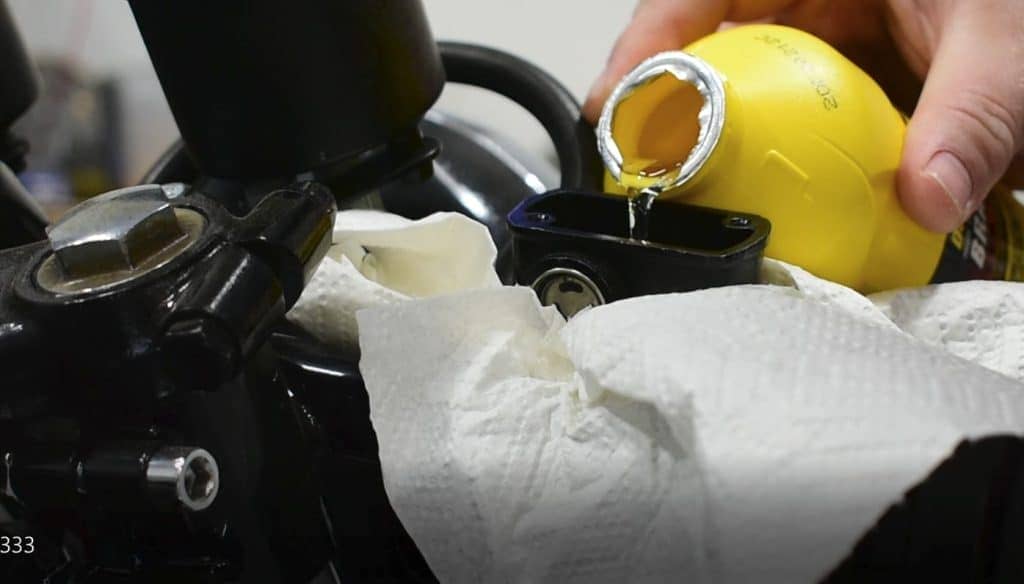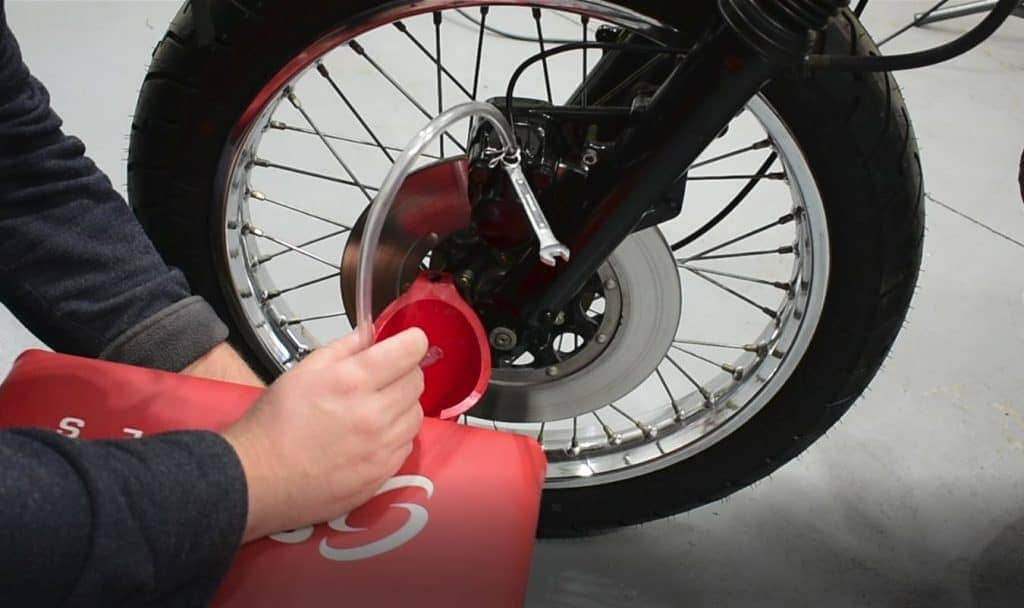
Your brakes are the last thing you want to lose while driving a motorcycle. Brakes are your best friend when it comes to having a safe trip on your two-wheeled adventures.
You are here to find the answer to a very valid question. I will go over with you the importance of brake fluid and why it does need to be changed periodically.
Does motorcycle brake fluid go bad? Motorcycle brake fluid does go bad just like other fluids on a motorcycle. If it is not changed at proper intervals, it can affect the stopping distance of your motorcycle. Dark colored brake fluid and a spongy feeling brake lever are signs that your motorcycle brake fluid has gone bad.
Keeping your motorcycle at peak performance is very important. This article will focus on why brake fluid goes bad and how you can stay safe while riding. The last thing we want is a rider down on the freeway or the canyon because their brake system was not in good condition.
Why Motorcycle Brake Fluid Goes Bad
Brake fluid has chemical properties that allow it to deliver top-level stopping power. Other fluids on your motorcycle like gear oil in the engine and transmission need to be changed because these chemical properties break down over time. Brake fluid is no different.
Your motorcycle brake fluid is one of the most important things keeping you from hitting a wall or a suddenly stopped vehicle in front of you. It is the fluid that jumps into action when you pull on your brake lever. When that lever is pulled it builds pressure in the braking system that causes the brake fluid to hydraulically actuate your brake calipers to press the brake pads onto the rotor allowing you to make a safe stop. That is why is important to know why brake fluid goes bad.
Motorcycle brake fluid can go bad by being exposed to extreme heat when riding the bike. Let’s say you go up to the canyons or the race track. You will probably put more stress on your brake system than normal because of the riding enthusiast you are. When you are cruising at those speeds the last thing you want is for your braking performance to disappear while riding.
Seizing or sticking brake calipers can cause the brake fluid to overheat in the system. This will cause a condition known as brake fade. You will feel the brakes not working as well as they have been and if you have a dragging caliper it will cause the bike to feel a bit sluggish.
While overheating the brake system is possible it is not the most likely suspect for bad brake fluid. The biggest factor in low-performing motorcycle brake fluid is moisture. That’s right, it’s water.
While the brake system is sealed it’s not 100% immune to water getting in. This can happen because you open the brake fluid reservoir to add fluid. Once the tiniest bit of air can get into the motorcycle brake fluid it can start to cause performance issues and break down the brake fluid.
Brake fluid is made to have a high boiling point similar to your engine coolant. This allows your braking system to perform well and not overheat even when doing some track or canyon riding. Water boils at 212 degrees Fahrenheit. Brake fluid boils at temps above 400 degrees Fahrenheit. Can you see what would happen if those two were mixed? Water or moisture would drop the boiling point of the brake fluid causing it to overheat a lot sooner than later.
How To Prolong The Life Of Motorcycle Brake Fluid
There are ways to keep your brake fluid in check and get the most life out of it. The biggest tip is to keep your lid on your brake fluid reservoir. The less time your motorcycle brake fluid is exposed to air the better. You only want to open that reservoir if you are changing the fluid.
If you are constantly adding brake fluid, that will indicate you have a leak somewhere in your brake system. We would advise not driving the motorcycle until the leak has been fixed by a professional motorcycle technician. If you’re having trouble with your motorcycle leaking brake fluid, check out our article “ Motorcycle Leaking Brake Fluid: 4 Likely Reasons.”
While it is fun to go to the track and push these machines to their limits, know that by doing so the brake fluid will be pushed hard as well. While you are cornering and using that brake lever more frequently and harshly the temps your brake system will see are much higher than the normal commute to work.
Avoid heavy braking when possible. This allows your brake fluid to stay cool and avoid overheating which will prolong its life as well. While you want to prolong your brake fluid as much as possible there are some signs that will let you know it needs to be replaced.
How To Tell If Your Motorcycle Brake Fluid Is Bad
The most obvious way to tell if the brake fluid is bad in your motorcycle is to look at the color. When the brake fluid is new it is a nice light gold color. When the brake fluid is exposed to moisture this fluid can get really dark and will look similar to dirty engine oil. If you see that it is starting to get a little dark it may mean the brake fluid is going bad.
If you notice contaminants floating around in your brake fluid like clumps of dirt or even rust flakes, that is a good sign that the brake fluid needs to be replaced. It could also mean potentially replacing calipers or lines if they are corroded or leaking due to contaminants in the brake fluid.
Another sign that brake fluid is bad is a very spongy feeling brake lever. This means that your brake lever needs to be pressed down a bit more than normal to make a safe stop. That indicates that there is moisture in the brake fluid as well.
If you notice that your brakes take longer to stop your motorcycle after using them a couple of times to slow down or to stop, it can indicate the brake fluid has gone bad. It is important to know these signs as they could mean life or death on the road. The good thing about the brake fluid is that it can be easily changed in your garage if you notice these kinds of symptoms.
How To Safely Change Your Motorcycle Brake Fluid

While it may sound daunting, it is fairly easy to change your bad brake fluid. We have an entire series that not only shows how to change your motorcycle brake fluid safely, but also how to tackle every part of rebuilding your motorcycle. You can see more about that by clicking here. There are some things that you will need before getting started:
- Brake Fluid
- Rags/Paper Towels
- Brake Parts Cleaner
- Drain Pan
- Plastic Hose
- Wrench
- Brake bleeder tool
- A Friend
You will know which kind of brake fluid to buy as it should be stamped on your brake fluid reservoir cap. If it is not, consult a dealer or your owner’s manual. You will want some towels or rags for quick clean-up for potential spills. Brake fluid is highly corrosive and will remove paint so make sure your painted parts are protected. You will want some brake parts cleaner just in case brake fluid leaks onto your rotors and pads.
The first step is to mask off any painted areas or cover them if they might come in contact with the brake fluid.
Next place your drain pan close enough to the brake caliper you will be changing the brake fluid first.
Then loosen the bleeder screw on the brake caliper with the proper wrench using the box end side to prevent stripping the screw. It will look like a small nut with a nipple on it. It may have a cover that needs to be removed to allow the brake fluid to drain. Loosen until you begin to see the fluid slowly seeping out of the bleeder screw.
Next, connect your brake fluid bleeder tool or plastic hose. Make sure it is secured so it doesn’t fall off. Also, point the plastic hose into the drip pan if you are not using a bleeder tool to catch the bad brake fluid.
Then remove the brake fluid reservoir cap. Some motorcycles may have two reservoirs, one for the front and one for the rear. Make sure to open the one associated with the side of the bike you are working on. If you notice flakes of contamination in the fluid it may be best to take your bike to a certified motorcycle technician to ensure those are removed from the system.
Next, have a friend or yourself slowly pull the brake lever. After a pump or two, you will see the brake fluid come out into your drain pan or bleeder tool.
Make sure to fill your brake fluid reservoir as you do this. You do not want air getting into your system. So you will add brake fluid as you pump the brakes. Do not let the fluid get below the minimum line while doing this or air will get into the system and it’s a paint to remove.
You will continue pumping the lever and adding brake fluid until the brake fluid you see coming out of the bleeder screw is golden and looks new.
Once you have reached that point tighten the bleeder screw. Clean up any brake fluid immediately to prevent any corrosion on painted surfaces or garage floors.
Remember to put the cap on your reservoir and voila! You have changed your brake fluid. Dispose of your old brake fluid at approved locations or dump sites.
Now, before you take off on a long trip or commute to work take your bike on a quick drive around the block to test the brakes. They will feel more firm and responsive if your brake fluid is bad. Return back to your garage to inspect for any leaks before heading out. Repeat this process for the other side you haven’t done yet if they do not share a reservoir.
Check out our other articles about how to keep your motorcycle in tip-top shape.
